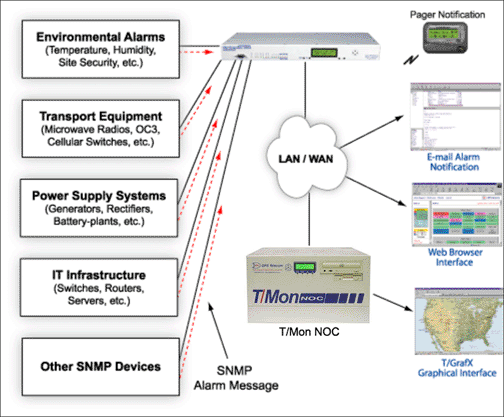Download our free SNMP White Paper. Featuring SNMP Expert Marshall DenHartog.
This guidebook has been created to give you the information you need to successfully implement SNMP-based alarm monitoring in your network.
1-800-693-0351
Have a specific question? Ask our team of expert engineers and get a specific answer!
Sign up for the next DPS Factory Training!

Whether you're new to our equipment or you've used it for years, DPS factory training is the best way to get more from your monitoring.
Reserve Your Seat TodayYou have a whole team of people working together to keep your network running reliably. They each have a unique role to play and different perspectives of your network. Your network monitoring system should be able to accommodate their different visibility needs. Technicians need phone notifications, supervisors may need email visibility and web browser access, and your network operations center (NOC) needs top-level visibility down to the nitty-gritty details.

T/Mon supports multiple notification and display methods to ensure that critical information gets to the people who need it, including alphanumeric and numeric pager notification, e-mail notification, a Web Browser interface, and optional presentation software that displays information on a geographic map of your network.
Maintenance technicians need network visibility in the field to rapidly respond to network integrity threats. T/Mons's phone notifications bring up-to-the-minute information about network problems directly to the maintenance personnel who can immediately correct them. The T/Mon includes full support for text/email alerts, so you can automatically send detailed notifications and instructions to cell phones.
The NOC's automatic escalation feature will make sure the alarm is acknowledged. If the first technician does not acknowledge the alarm within a user-specified time (usually 10 minutes or so), a backup technician will receive an SMS. If neither technician responds, a supervisor will be texted. You don't have to worry that alarms are piling up unnoticed.
Senior supervisors don't have the time to monitor alarms from the NOC, but they need to stay informed of network events. E-mail notification lets busy managers know what's going on with their networks and provides an easily accessible alarm record. The familiar e-mail interface provides network visibility to everyone without the need for specialized training. And with e-mail notifications, alarms can be acknowledged simply by sending a reply e-mail.
Many people in your organization need access to alarm monitoring data, and not all of them are in your network operations center. T/Mon's Web Browser interface lets personnel view and acknowledge alarms from any computer on your network. With the Web Browser interface, you're not tied to proprietary monitoring consoles to control your system. Supervisors have instant access to monitoring information from their desktops, and it's easy to rotate monitoring staff at different locations.
System security for multiple users is guaranteed. The system administrator can create an individual security profile for each user, allowing precise control of user access. For each user, you can limit what alarms may be viewed, which alarms may be acknowledged, which controls and system commands may be issued, and what modifications may be made to the system configuration.
Your primary monitoring staff needs complete information on every aspect of your network, and they need to be able to quickly locate problems. T/GrafX software creates a war-room display right on your PC desktop, giving an immediate bird's-eye view of your entire network. T/GFX uses maps, icons, and photos to create a graphic display of your entire network. At the top-level view, you have an at-a-glance indication of the state of your entire territory; multi-layer graphics let you zoom down to site, building, equipment rack, device, and alarm point to view specific alarm information.